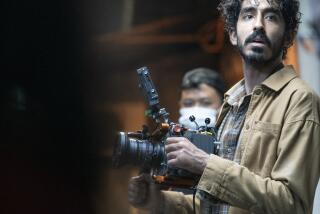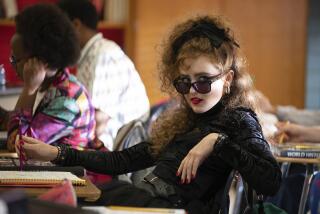Jordan Peele’s ‘Us’: 11 surprising influences behind the horror hit
Like Adelaide Wilson, the heroine of “Us,” Jordan Peele was a wide-eyed kid poring over all things pop culture in the 1980s, when everything from scary movies to Michael Jackson’s “Thriller” imprinted indelibly on his young psyche.
As a result, a cornucopia of movie references abound in “Us,” adding further layers to Peele’s record-breaking horror tale about a family battling their own doppelgangers. With a twist ending that has viewers buzzing and coming back for repeat viewings, the mysteries of “Us” unfold the more you venture down the rabbit hole.
Which cinematic influences made their way into the film? Read on for 11 of Peele’s more surprising inspirations.
Warning: Plot spoilers follow.
This is ‘Us’: Jordan Peele wants Americans to ‘face their demons’ in new home-invasion horror film »

“Jaws” (1975)
As he did in his Oscar-winning debut “Get Out,” Peele wears his genre bonafides proudly on his sleeve. Young Jason (Evan Alex) — who has a habit of wearing a mask, like another famous horror movie Jason — wears those nods on his T-shirt, sporting a “Jaws” tee during a suspenseful family trip to the beach. Later, Peele channels the Steven Spielberg classic, subjecting Winston Duke’s character to one of his own personal phobias (“an open body of water at night,” Peele revealed to The Times in an interview) in a scene in which the boat-obsessed Gabe must fight his own waterborne predator in the form of his Tethered double, Abraham.
Review: The evil is ‘Us’ in Jordan Peele’s smart, relentlessly scary follow-up to ‘Get Out’ »
“The Lost Boys” (1987)
Pivotal sequences set in two different times were filmed on location at Santa Cruz Beach Boardwalk, the coastal Northern California amusement park horror fans also know as the fictional Santa Carla setting of “The Lost Boys,” Joel Schumacher’s cult 1987 vampire horror flick. Do the math, and it would have been filming around the time 9-year-old Adelaide and her bickering parents went out for a night on the boardwalk.
“In ‘The Lost Boys’ the threat comes from above; without giving anything away this film is the mirror image of that,” Peele said. When Adelaide’s mother mentions a film crew shooting nearby might be looking for extras, she’s referring to “The Lost Boys.” “There’s a line in the boardwalk scene, one of the characters mentions there’s a movie shooting near the carousel...”
“Martyrs” (2008)
Before filming, Peele gave stars Lupita Nyong’o and Winston Duke films to watch to establish a shared movie language on set to guide the cast’s complex dual performances and trickster storytelling. Some titles on that list featured themes and motifs found in “Us,” like the spooky twins of “The Shining” and the nerve-fraying home-invasion thrills of Michael Haneke’s “Funny Games.”
Nyong’o got through more of Peele’s suggestions — “The Babadook,” “It Follows,” “A Tale of Two Sisters,” “The Birds,” “Let the Right One In,” “The Sixth Sense” and “Alien” — before she came to a daunting final watch: Pascal Laugier’s ultraviolent 2008 French psychological horror tale “Martyrs,” about a woman confronting disturbing traumas and the machinations of a sadistic cult. Not that Peele’s warning helped, she recalled: “With the last one, he wrote: ‘Enter at your own risk.’ ”
“C.H.U.D.” (1984)
Peele winks at his audience from the start in his opening prologue: As 9-year-old Adelaide watches TV circa 1986, the camera reveals the family’s VHS collection, which includes 1985’s subterranean kids adventure “Goonies.” Even the 1983 space drama “The Right Stuff,” from “Invasion of the Body Snatchers” director Philip Kaufman, mirrors the sense of idealistic ’80s American can-do that underscores a fanatical Red’s subsequent mission for justice, and the notion that staging a Hands Across America-esque stunt will command the world’s attention.
But one VHS tape on the family movie shelf will catch true genre aficionados’ eyes: The 1984 cult sewer sci-fi horror flick “C.H.U.D.” (short for Cannibalistic Humanoid Underground Dweller), in which once-human creatures ascend out of the depths below New York City, foreshadows the horrors to come.
“A Nightmare on Elm Street 3: Dream Warriors” (1987)
The Bay Area rap classic “I Got 5 on It” plays double duty in “Us” in the increasingly horrific nightmare that befalls the Wilsons: But first, as they drive toward their Santa Cruz summer vacation home, the whole family — mom Adelaide (Nyong’o), dad Gabe (Duke), son Jason (Alex), and daughter Zora (Shahadi Wright Joseph) bond by singing along to the 1995 Luniz track in the car.
Later, the song takes a menacing turn when the slowed-down, string version provides the backdrop to Adelaide’s underground showdown with her doppelganger, Red (also Nyong’o). The darker version of “I Got 5 on It” reminded Peele of a score by composer Angelo Badalamenti of “Twin Peaks” fame (whose work with David Lynch also includes the 2002 project “Rabbits”).
“This song has always had a haunting melody — the bass line and that riff kind of sounds like Angelo Badalamenti’s ‘Nightmare on Elm Street [3]’ score,” Peele said. “I knew I wanted to have a Bay Area classic hip-hop song... It kind of serves the same purpose as ‘Redbone’ [in “Get Out”] and gets everybody’s heads bopping — then all of a sudden, there’s a haunting aspect.”
Michael Jackson’s “Thriller” (1983)
Michael Myers’ signature coveralls and Freddy Krueger’s gloves also find their way into the costume influences and color palettes of “Us.” But Michael Jackson’s iconic red “Thriller” jacket — and his music video transformation into a zombie and werewolf — subtly influences young Adelaide, who wears a “Thriller” shirt her dad wins on the boardwalk.
Like Jackson in “Thriller,” the Tethered also wear red clothing, a single glove and familiar faces distorted into monstrous visions. In the 1980s, the singer was a globally adored figure “with a great duality,” said Peele, acknowledging that the added specter of Jackson’s now-divisive legacy and more recent accusations of child sexual abuse lend even more unintended weight to the reference.
“Dead Again” (1991)
Kenneth Branagh’s time-hopping 1991 romantic thriller might make an unexpectedly interesting double feature with “Us”; it’s another of the movies Peele asked his stars to study ahead of filming, and one that echoes with similar themes. Branagh and Emma Thompson play lovers linked in the present to their past-life doppelgangers, in a mystery of true identities notably punctuated by the presence of a familiar household implement-turned-deadly weapon: scissors.
“The Nutcracker”
It’s not a specific film, but the classic ballet in which a young girl travels into a shadow realm on Christmas inspired a flashback, marking a pivotal moment in Adelaide and Red’s tethered years after the girls switched in the funhouse in 1986. Peele and choreographer Madeline Hollander reenvisioned the ballet’s two-person pas de deux as a solo dance performed by a teenage Adelaide, whose actions are mirrored by Red performing a version of the dance down below.
“Rob Roy” (1995)
When the two women meet again as adults, they face off in the very tunnels where Red’s dance revealed her special status to the rest of the Tethered and led to her eventual emergence as their leader. To nail the Lupita-on-Lupita fight to the death, Peele took inspiration from the 1995 biopic “Rob Roy.”
“We looked at different fight scenes in history,” said Peele. “One was the Tim Roth-Liam Neeson scene in ‘Rob Roy,’ which was a very character-driven sequence. Another thing for me in a horror movie is that it doesn’t begin to feel like an action movie fight. Horror and violence is brutal, it’s improvisational, it’s clumsy at best. So with Lupita we really worked her to the bone… and then used about 25% of it. Sorry!”
“Key & Peele”
Duke and Nyong’o had a secret weapon while filming the comedic moments in “Us”: Jordan Peele. The veteran comedy performer brought his improvisational skills behind the camera, which came in handy during a scene in which Duke’s Gabe is sizing up the mysterious strangers who have appeared in the driveway, baseball bat in hand.
“I trusted Jordan in every way to be like, ‘Is that funny? Is this working?’” said Duke. The scene was very much “like a ‘Key & Peele’ sketch,” Peele said, laughing.
“And we laid into that,” added Duke. “It’s really funny and playful and he’s trying to keep his sense of what’s mundane – it has to be another family, it has to be neighbors, this can’t be anything else – there’s humor in that.”
“The Twilight Zone” (1960)
Peele cites “Mirror Image,” the chilling 1960 TV episode from Season 1 of Rod Serling’s “The Twilight Zone,” as inspiration for “Us.” In it, a sensible young woman waiting at a bus station sees her own double and suspects that something she once read is true: That parallel universes exist, and when they collide with ours, evil imposters can cross over and take over our lives.
Perhaps unsurprising, Peele executive produced and narrates an upcoming CBS All Access reboot of the celebrated sci-fi series, which promises to expand his oeuvre as audiences keep turning over every discernible detail of “Us” in search of answers.
More to Read
Only good movies
Get the Indie Focus newsletter, Mark Olsen's weekly guide to the world of cinema.
You may occasionally receive promotional content from the Los Angeles Times.







